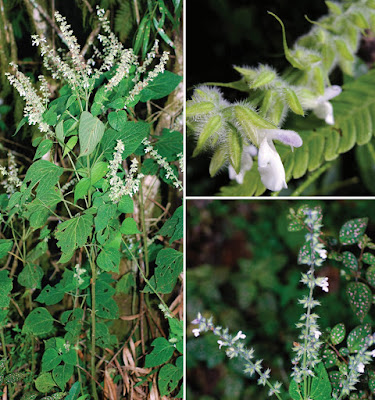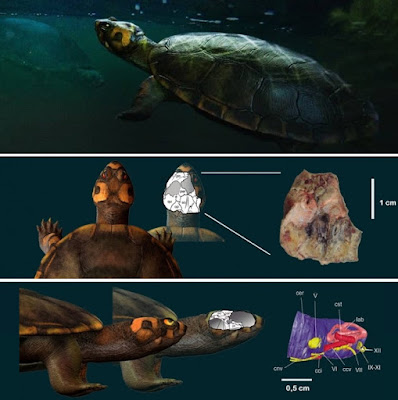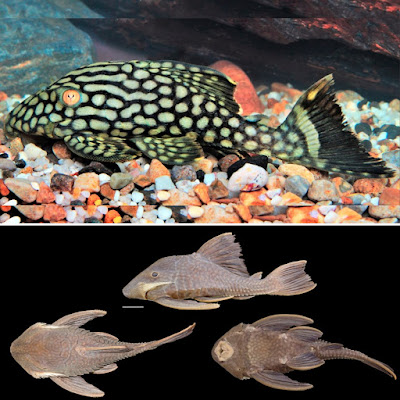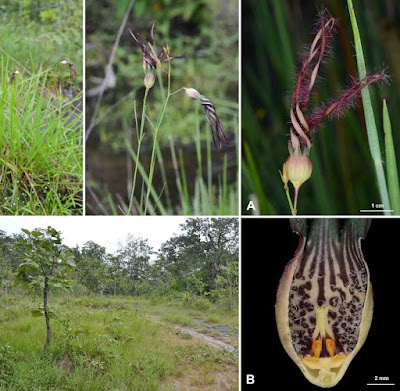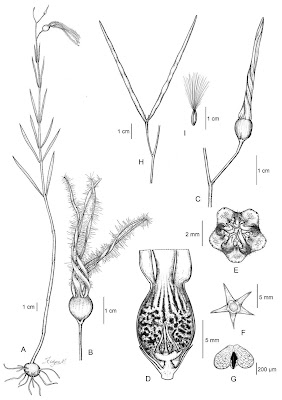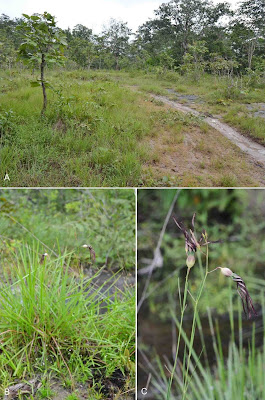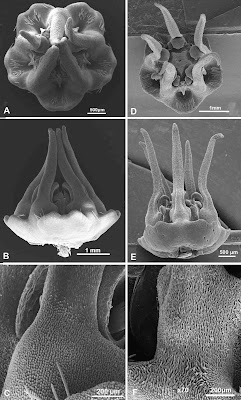[Most Recent Entries] [Calendar View]
Saturday, February 15th, 2020
| Time | Event | ||||
| 7:47a | [Botany • 2020] Salvia huastecana (Lamiaceae) • A New Species from San Luis Potosí, Mexico
Abstract Salvia huastecana is described and illustrated as a new species. It is known from the municipality of Xilitla, San Luis Potosí, Mexico. This taxon belongs to Salvia sect. Angulatae, is similar to S. albiflora and S. roscida but it can be distinguished by a higher number of flowers per verticillaster (9−12), longer caducous bracts with long caudate apex, hirsute calyx with erect trichomes and white corolla, sometimes with the upper lip and margins of the lateral lobes of the lower lip light blue stained. Photographs of living plants and the illustration of the new species are provided. Keywords: México, Salvia, Lamiaceae, Eudicots Salvia huastecana Bedolla, Zamudio & H.Castillo-Gómez, sp. nov. Salviae albiflorae et S. roscidae similis. Sed a priore differt inflorescentia cum 9−12 floribus in quoque verticillastro (vs. 5−9), bracteis floralibus longioribus (5.5−14 vs. 2.5−5.6 mm), apice longe-caudato (vs. acuto vel acuminato), caduco (vs. longe persistente); calyx hirsutus (vs. puberulus trichomatibus adpressus); et a altero differt corolla alba vel alba cum labio supero et labii inferi margine sublazulino (vs. albo). Distribution and ecology:— Populations of the new species occur in two localities in the municipality of Xilitla, in the southern portion of San Luis Potosí (Fig. 3). It inhabits on limestone rock slopes with remnant elements of montane cloud forest with Clethra pringlei S.Watson, Cnidoscolus albidus Lundell, Myriocarpa sp., Podocarpus reichei J.Buchholz & N.E.Gray, Rhamnus capreifolia Schltdl. y Saurauia sp., in an elevation range from 1427–1465 m. Etymology:— The specific epithet “huastecana” refers to the Huasteca region, seat of the Teenek or Huasteca culture that was established more than one thousand year ago in the southern portion of San Luis Potosí (Puig 1991), area in which the species was found. Brenda Y. Bedolla-García, Sergio Zamudio and Hugo A. Castillo-Gómez. 2020. Salvia huastecana (Lamiaceae), A New Species from San Luis Potosí, Mexico. Zootaxa. 433(1); 1–8. DOI: 10.11646/phytotaxa.433.1.1 | ||||
| 9:18a | [Paleontology • 2020] Amabilis uchoensis • A Small Podocnemidoid (Pleurodira, Pelomedusoides) from the Late Cretaceous of Brazil, and the Innervation and Carotid Circulation of Side‐necked Turtles
Abstract Pleurodires are less diverse than cryptodires, together forming the two major lineages of crown turtles. Their fossil record, however, is rich. A particularly large number of fossil pleurodires, many belonging to the Podocnemidoidae, has been recovered from the Upper Cretaceous Bauru Group outcrops of south‐central Brazil. Herein we describe an additional pleurodire from this region, Amabilis uchoensis gen. et sp. nov., based on a partially preserved skull. A. uchoensis is recognized as belonging to the Podocnemidoidae by the small entrance to the antrum postoticum and completely developed cavum pterygoidei, being unique among other non‐podocnemidid podocnemidoids for its medially open fenestra postotica and absent basioccipital–opisthotic contact. Our cladistic analysis places A. uchoensis as a sister taxon to Hamadachelys + other podocnemidoids. We further explore the neuroanatomy of side‐necked turtles with the aid of micro‐computed tomography of specimens of the main pleurodiran lineages. Our data shed light on the different carotid circulation patterns in pleurodires, and we propose new phylogenetic characters to describe the neuroanatomical variation of the group. Optimization of these characters shows two independent acquisitions of a foramen for the palatal branch of the carotid in chelids and podocnemidoids, and a unique loss of the vidian nerve canal in chelids, in turtles in general. Keywords: Pleurodira, micro‐computed tomography, Podocnemidoidae, Bauru Group, neuroanatomy, carotid circulation Systematic palaeontology PLEURODIRA Cope, 1864 PELOMEDUSOIDES Broin, 1988 PODOCNEMIDOIDAE Cope, 1868 Genus AMABILIS nov. Derivation of name: Latin for ‘lovable’, for its tiny size. Amabilis uchoensis sp. nov. Derivation of name: The name refers to Uchoa municipality, where the holotype is housed. Conclusion: The new podocnemidoid turtle from the Late Cretaceous São José do Rio Preto Formation increases the diversity of taxa on the stem‐lineage to Podocnemididae, highlighting the importance of the Bauru Group fossils in the understanding of the origins of the group (Fig. 7B). Based on an exclusive set of characters, A. uchoensis can be attributed to the Podocnemidoidae lineage. Also, based on μCT data, new characters were proposed, previous scorings were re‐interpreted, and these were included in a new phylogenetic analysis. The recovering of some of these novel characters as synapomorphic for main pleurodiran clades (e.g. Pelomedusoides, Bothremydidae) indicate that, as with other vertebrates (e.g. Coates 1999; Mennecart et al. 2017; Pierce et al. 2017), neuroanatomy reflects important phylogenetic signals also for pleurodires. Our investigation has revealed a previously unknown variety of carotid circulation patterns in pleurodires. Among Testudines, we find a single loss of the canal for the palatal (vidian) branch of the facial nerve (VII) in chelids, as suggested by Albrecht (1976). We also mapped two independent origins of a specific foramen for the palatal branch of the carotid artery, in chelids and in the Podocnemidoidae lineage, although the origin of this foramen appears to be homoplastic across turtle lineages (Fig. 8), given that the presence of the canal varies outside crown Testudines (e.g. present in plesiochelyids and absent in baenids; Rollot et al. 2018; Evers & Benson 2019; Raselli & Anquetin 2019). Furthermore, taphrosphyine bothremydids evolved one of the most lateralized paths for the internal carotid among pleurodires, in which the canal extends virtually perpendicular to the midline axis of the skull, whereas in the majority of pleurodires (and turtles in general) the carotid enters the braincase at a much more acute angle. We hope that this contribution will serve as a basis for future surveys exploring the inner skull anatomy of a larger sample of pleurodires, broadening our understanding of the evolution of the cranial innervation and carotid systems in the group. Guilherme Hermanson, Fabiano V. Iori, Serjoscha W. Evers, Max C. Langer and Gabriel S. Ferreira. 2020. A Small Podocnemidoid (Pleurodira, Pelomedusoides) from the Late Cretaceous of Brazil, and the Innervation and Carotid Circulation of Side‐necked Turtles. Papers in Palaeontology. DOI: 10.1002/spp2.1300 Amabilis, nossa tartaruga de 85 milhões de anos diariodaregiao.com.br/_conteudo/2020/02/c | ||||
| 9:41a | [Ichthyology • 2020] Panaque nigrolineatus laurafabianae • A New, Commercially exploited Subspecies of Ornamental Wood-eating Pleco (Loricariidae: Hypostominae) from the Guaviare River Basin in Colombia
Abstract The suckermouth armored catfish genus Panaque contains seven valid species, including the Royal Pleco, Panaque nigrolineatus, which has long been popular as an ornamental aquarium fish and was originally described from the Apure River basin in Venezuela. We examine a phenotypically distinct population of P. nigrolineatus from the Guaviare River in southern Colombia at the southwesternmost corner of the Orinoco River basin. In contrast to typically boldly striped populations from closer to the type locality of P. nigrolineatus, the Guaviare River basin population is usually boldly spotted, earning them the common name Watermelon Pleco in the aquarium fish trade. Because of the commercial popularity of this distinctive color morph, it is heavily exploited for export to the global ornamental fish trade. We find that the Guaviare River P. nigrolineatus laurafabianae is not only distinct geographically and in color pattern, but is also morphometrically diagnosable from P. nigrolineatus individuals from outside the Guaviare River basin. However, relatively subtle phenotypic differences, invariance in nuclear DNA markers, < 0.5% divergence in mitochondrial DNA markers 16S, cytb, and ND2, and the non-monophyly of Guaviare River populations prevent us from robustly inferring species-level distinctiveness of the Watermelon Pleco. We therefore propose to recognize this population as a distinct subspecies. Keywords: Loricariidae, Taxonomy, Neotropics, Orinoco, coloration, wood-eating, ornamental aquarium fishes Armando Ortega-Lara and Nathan K. Lujan. 2020. Panaque nigrolineatus laurafabianae, A New, Commercially exploited Subspecies of Ornamental Wood-eating Pleco (Loricariidae: Hypostominae) from the Guaviare River Basin in Colombia. Zootaxa. 4732(3); 393–408. DOI: 10.11646/zootaxa.4732.3.3 | ||||
| 9:59a | [Botany • 2020] Ceropegia phuchongensis (Apocynaceae: Asclepiodoideae) • A New Species from eastern Thailand
Abstract A new species from Phu Chong-Na Yoi National Park, Ubon Ratchathani Province, eastern Thailand, Ceropegia phuchongensis Kidyoo & K. Suwann. (Apocynaceae, Asclepiadoideae), is described, illustrated and compared with the related C. tenuicaulis Kidyoo. The new species differs in corolla tube shape, color and trichomes inside the corolla tube, as well as pollinium and corpusculum shape. In addition, the gynostegium surfaces of the two species also support the distinctiveness of the new species. Keyword: Apocynaceae, Asclepiadoideae, Ceropegieae, dry deciduous forest, grass-like habit, Thailand, Tiloris
Ceropegia phuchongensis Kidyoo & K. Suwann., sp. nov. Diagnosis: Ceropegia phuchongensis differs from C. tenuicaulis in having an ovoid to globose corolla tube of 0.7–1.0 cm length and 0.6–0.9 diam. which is inflated at its mid-length. The interior of this inflated part is yellowish white with irregular purplish brown dots and stripes, and densely covered with wrinkled, whitish trichomes of 0.9– 1.5 mm length. In contrast, C. tenuicaulis has an ovoidtubular corolla tube of 1.7–2.2 cm length and 0.5–0.6 cm diam. The tube has a slightly inflated basal portion and a long narrow upper part. The interior of its inflated part is plain purplish brown and covered with scattered white trichomes of 0.7–1.4 mm length. Etymology: Ceropegia phuchongensis is named after the Phu Chong-Na Yoi National Park, the type locality. Distribution and habitat: Ceropegia phuchongensis is currently known from only two localities in eastern Thailand. This plant is a perennial herb growing in sandy soil among tall grasses in the open area of dry deciduous dipterocarp Manit Kidyoo and Kamonchanok Suwannakote. 2020. Ceropegia phuchongensis (Apocynaceae, Asclepiadoideae), A New Species from eastern Thailand. Taiwania. 65(2); 101-108. |
| << Previous Day |
2020/02/15 [Calendar] |
Next Day >> |
